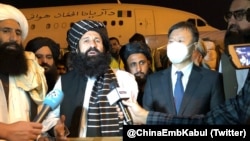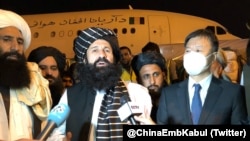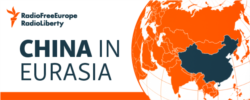
Welcome back to the China In Eurasia briefing, an RFE/RL newsletter tracking China’s resurgent influence from Eastern Europe to Central Asia.
I’m RFE/RL correspondent Reid Standish and here’s what I’m following right now.
Beijing's Attention Turns To Security In Central Asia And Afghanistan
The Taliban has removed Uyghur militants from an area near Afghanistan’s border with China in a move that signals growing coordination between Beijing and the Afghan militant group, RFE/RL’s Tajik Service and I reported.
Finding Perspective: The relocation of Uyghur militants marks the first known instance of the Taliban taking action on the ground to assuage Chinese fears since they toppled the Afghan government in August.
It is not known whether the Taliban will hand over the fighters to Chinese authorities or simply plans to relocate them, but it marks a new sign of cooperation with Beijing.
However, analysts caution that the Taliban is still walking a fine line in its burgeoning partnership with China.
During the Taliban’s previous reign in 1996-2001, the group also relocated Uyghur militants from the border regions to other parts of Afghanistan to calm Chinese concerns but stopped short of handing over fighters to Chinese authorities, which strained ties between Beijing and the Taliban.
Andrew Small, a fellow with the German Marshall Fund in Berlin who tracks Chinese activities in South Asia, said that the Taliban may be looking to replicate that strategy.
“This is in keeping with what happened when they were in power before,” Small said. “The Taliban have sought to avoid embarrassment with China as a result of any Uyghur militant activities, but it would be a very different matter if they actually handed them over.”
Why It Matters: Beijing is focused on security concerns in Afghanistan and how they could spill over into neighboring Central Asia, leaving China with a complicated hand to play.
Working with the Taliban on counterterrorism is one way to help mitigate that, but the jury is still out on whether China and the group can fully cooperate together.
In the meantime, China is worried about an impending humanitarian crisis in Afghanistan and is aiming for sanctions against its neighbor to be lifted as part of a wider push by Beijing to gain more international political support for the Taliban.
Such measures could also give Beijing more sway over the group, as I explained in this article. The West, however, still controls many of the large financial levers over Afghanistan.
Read More
● Afghanistan’s Central Asian neighbors have also begun engaging more directly with the Taliban. Both Kazakhstan and Kyrgyzstan sent delegations and my colleague Bruce Pannier explains the significance here.
● Tensions between Tajikistan and the Taliban continue to simmer, with the militant group providing Tajik militants based along the border between the two countries with new military vehicles, weaponry, and other equipment over the past two weeks, RFE/RL’s Tajik Service reported.
● Has China’s global power already peaked? That’s the argument that Hal Brands and Michael Beckley make in Foreign Policy magazine. Read it here.
Expert Corner: Central Asia's Not-So-Great Games
Readers asked: “Washington is talking with Russia about using its bases for counterterrorism operations in Afghanistan. What does this mean and where do Beijing and Moscow stand?”
To find out more, I asked Alexander Gabuev, a senior fellow at the Carnegie Moscow Center.
“What Russia is offering is that the United States can use their facilities [in Central Asia] and can be stationed there with Russian forces. It’s mostly about some monitoring and the ability to launch drone strikes from a closer location than at the moment, which is from the Gulf.
“A lot depends on what the U.S. presence there would actually look like, but it’s not necessarily against Russia’s interests, or even China’s to an extent, for the U.S. to still be conducting counterterrorism operations in Afghanistan.
“I don’t know if the United States will take such an offer. Washington would prefer to have their own base and not be so close to Russian forces, where they would be spied on and watched closely.
“I also don’t know if the Central Asian countries want to host a U.S. base again and start up these dynamics that they previously had with American military bases in the region, but again, let’s see where the talks go.”
Do you have a question about China’s growing footprint in Eurasia? Send it to me at StandishR@rferl.org or reply directly to this e-mail and I’ll get it answered by leading experts and policymakers.
Three More Stories From Eurasia
1. The View From The Ground
At the top level, ties between Beijing and the Kremlin are deepening, but in Ulyanovsk, a region of Russia some 850 kilometers east of Moscow, a different portrait of the China-Russia relationship is unfolding.
Paper Vs. Reality: Unpacking this complex dynamic is the focus of a recent series by RFE/RL's Tatar-Bashkir Service, which took an up-close look at ties between the two countries at the ground level.
Through interviews with local officials, activists, and experts, the Ulyanovsk region is seen as a potential future location for China's economic footprint to grow in Russia.
At the local level in Ulyanovsk, this has included deepening trade links, a burgeoning tourism sector, and future infrastructure deals -- including plans for a Chinese-funded highway project through Russia that is meant to connect Europe to western China.
But this development faces pushback from local residents. There are also difficulties in translating deals into real projects on the ground, despite the partnership's top-level endorsement.
For instance, much of the cooperation is frozen due to COVID-19 precautions and many local officials and business owners told RFE/RL’s Tatar-Bashkir Service that they had no idea when or if they would resume.
2. Belt And Road Woes
Over the past several years, hidden debt and problematic projects have begun to emerge as a feature of Chinese leader Xi Jinping’s signature Belt And Road Initiative (BRI).
A new deep-dive study from AidData, a research center at the College of William and Mary in Virginia, adds to this body of research and paints a picture of growing headwinds against Beijing’s infrastructure initiative.
Key Takeaways: The study found 42 low- and middle-income countries that now have debt exposure to China exceeding 10 percent of their annual gross domestic product (GDP).
Among those nations, the researchers identified $385 billion in Chinese loans that were not included in official statistics. That equates to nearly half of China’s overseas lending for the construction of roads, railways, and other projects being hidden.
Other notable findings from the report are that an estimated 35 percent of Chinese infrastructure projects have been hit by scandals involving corruption, environmental problems, or labor violations.
Spotlight On Eurasia: My colleagues at RFE/RL’s Kazakh Service and Uzbek Service both dug into Central Asia’s presence in the study.
While Uzbekistan’s debt to Beijing continues to grow, Kazakhstan -- along with Turkmenistan -- were among the countries with a particularly high hidden debt.
Nur-Sultan’s official debt owed to China was below 10 percent of GDP, but the study showed that its hidden levels exceeded the 10 percent threshold, making it part of the report’s top tier.
3. Ukraine’s China Window
China is investing more and more in Ukraine, a trend welcomed by both the Chinese and Ukrainian governments. But as my colleague Yevhen Solonyna from RFE/RL’s Ukrainian Service reports, that cooperation may come with hidden costs for Kyiv.
The Price Tag: Chinese investment in Ukraine has quadrupled in the past five years to $260 million. While that’s a big jump, the overall figure is quite small, and Chinese foreign direct investment (FDI) accounts for just 0.5 percent of Ukraine’s total.
But Chinese investment continues to grow, and Ukraine is weighing the costs.
Kyiv has also already faced pressure from China -- with Beijing holding up a vaccine shipment in order to get Ukraine to drop its support for added scrutiny of human rights abuses in Xinjiang, as Solonyna and I reported in July.
Moving forward, Kyiv is trying to walk a fine line between attracting much-needed Chinese funds and shielding itself from geopolitical pressure, a balance that might be too difficult to hold, officials and experts told Solonyna.
Across The Supercontinent
Damage Control: Kazakhstan's human rights commissioner, Elvira Azimova, held a rare meeting with a group of protesters whose relatives are being held in custody in Xinjiang, RFE/RL's Kazakh Service reported.
600 Days And Counting: China’s Xi Jinping hasn’t left the country in more than 600 days, but the European Union is hoping that they can get some much needed face time with the Chinese president, the South China Morning Post reported.
Xi is expected to have a phone call with European Council President Charles Michel to talk about rising tensions between China and the bloc. A summit between Beijing and the EU’s 27 members is a possibility, but many countries are reportedly only interested if Xi will meet in person.
Green Promises: Xi announced at the UN General Assembly that Beijing would look to stop building coal-fueled plants abroad. As my colleague Milorad Milojevic from RFE/RL’s Balkan Service reports, the call caught several Chinese projects in the region off guard.
Crunch Time: China is experiencing blackouts as part of an energy crisis spurred by coal shortages and rising fuel prices. Energy experts are warning that Europe may face power outages this winter and China’s factories could temporarily shut down.
One Thing To Watch
The September 22 release of two Canadians from China -- former diplomat Michael Kovrig and businessman Michael Spavor -- and the return of Huawei executive Meng Wanzhou serves as an opportunity to take stock of the Chinese telecommunications giant’s current fortunes.
When Meng was arrested in Vancouver at the request of U.S. authorities over accusations of violating U.S. sanctions on Iran, Huawei was riding high.
But since then, the tech giant has experienced a quiet decline as it has been the target of global blowback against China and pummeled by a U.S. diplomatic and sanctions campaign.
In August, Huawei announced that its revenue had dropped by 29 percent in the first half of 2021, with its chairman saying that the company’s “aim is to survive.”
This leaves Huawei as an early casualty of the tech war between China and the United States. Expect more to come as things intensify.
That’s all from me for now. Don’t forget to send me any questions, comments, or tips that you might have.
Until next time,
Reid Standish
If you enjoyed this briefing and don't want to miss the next edition, subscribe here. It will be sent to your inbox on Wednesdays twice a month.













